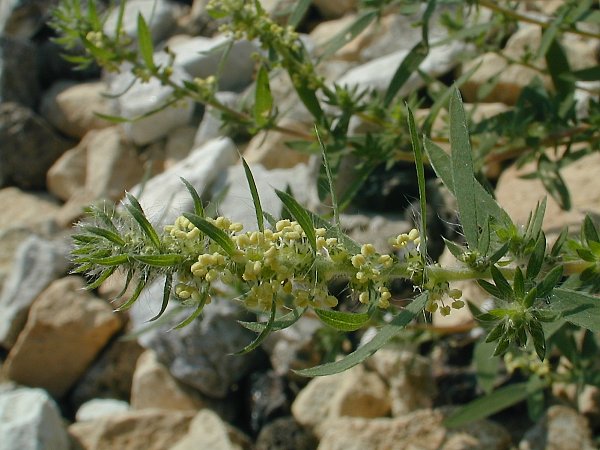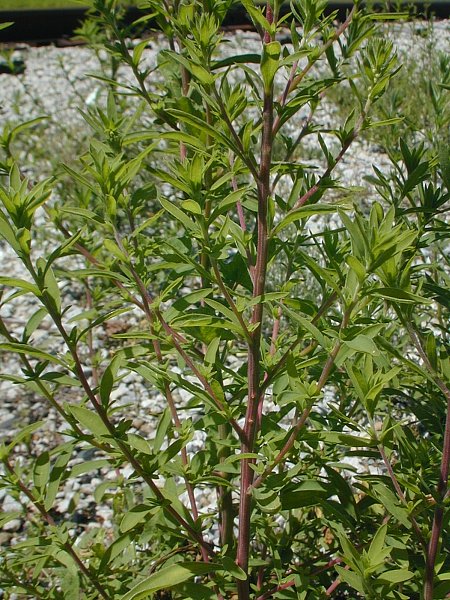Description: This plant is a summer annual that is highly variable in size, ranging from 1-6' tall. Large plants branch frequently and are wider at the base. Young stems are pubescent, but older stems near the base are usually glabrous. The alternate leaves are up to 2½" long and ¼" across. They are linear, narrowly lanceolate, or narrowly oblanceolate, and sessile against the stems. Their margins are smooth and ciliate. Clusters of 2-6 flowers develop near the axils of the leaves in young stems. These clusters of flowers slowly lengthen to become short hairy spikes about ½–2" long. These spikes have leafy bracts that are about ½" long and linear in shape. The silky hairs of the spikes can be as long as the bracts. Each flower is about 4-5 mm. across, consisting of a divided style, 5 stamens with large yellow anthers, 5 green sepals, and no petals. Each sepal is shaped like a blunt triangle and becomes winged along its outer surface as the flower matures into a fruit. The flowers are greenish yellow in overall appearance – were it not for their abundance along the stems, they would be rather inconspicuous. The blooming period occurs from mid-summer to early fall and lasts about 1-2 months. Each flower is replaced by a somewhat flattened capsule that contains a single seed. This capsule is enclosed by the sepals until it is ready to release the seed. The flattened seed is well-rounded on one end and tapers to a point on the other, resembling a teardrop. It is more or less brown and has a rough surface. During the fall or winter, Kochia often breaks off at the base of the central stem and becomes a tumbleweed that is driven about by the wind, in this manner distributing its seeds. The root system consists of a taproot. This plant spreads by reseeding itself, and sometimes forms colonies.

Cultivation:
The
preference is full sun, dry conditions, and a barren soil that is sandy
or gravelly. Soil with a high pH is readily tolerated.
Range & Habitat:
The non-native Kochia occurs occasionally in central and northern
Illinois, but it is
less common or absent in southern Illinois (see Distribution
Map). However, Kochia is still spreading into many areas of
the state where it was not previously observed. Habitats include
pastures, roadsides, areas along railroads, landfills and urban dumps,
and sterile waste areas. In Illinois, Kochia is primarily a weed along
railroads. It prefers disturbed sites and has not invaded natural
habitats to any significant degree, although it could potentially
invade gravel and sand prairies in the future. Kochia can appear in
recently burned over areas because of its tumbleweed characteristic. It
is native to Asia.
Faunal Associations:
The flowers are wind-pollinated and do not attract many insects. The
fuzzy orange caterpillars of Spilosoma virginica
(Virginia Tiger Moth) feed on the foliage (personal observation). This
moth species is highly
polyphagous and attacks a variety of weedy plants in the Goosefoot
family. Several species of grasshoppers also feed on the foliage of
Kochia, including Dissosteira
carolina (Carolina Grasshopper), Melanoplus bivittatus
(Two-striped Grasshopper), Melanoplus
differentialis (Differential Grasshopper), Melanoplus femurrubrum
(Red-legged Grasshopper), Phoetaliotes
nebrascensis (Large-headed Grasshopper), Spharagemon collare
(Mottled Sand Grasshopper), Melanoplus
lakinus (Lakin Grasshopper), and Brachystola magna
(Plains Lubber Grasshopper); see Wyoming Agr. Exp. Station (1994),
Brust et al. (2008), and Joern (1985). The last two species of
grasshopper occur west of Illinois. During the early stages of growth,
Kochia is highly palatable to all classes of livestock, and it is also
browsed by deer. However, if the foliage of mature plants is eaten in
large quantities, it can cause toxic reactions in livestock,
including photosensitization and neurological problems (Casey, 2009).
Another mammal, the Prairie Vole, also feeds on the foliage and
possibly other parts of Kochia (Fleharty & Olson, 1969).

<Photographic
Location:
Along a railroad in Champaign, Illinois.
Comments:
What distinguishes Kochia from similar species in the Goosefoot family,
such as Salsola kali (Russian Thistle), is the lack
of significant thorns or prickles in the foliage. There is a cultivated
form of
Kochia that is occasionally grown in gardens as an ornamental plant.
This cultivated form is quite different in appearance, having foliage
that is light green and softer in texture than wild Kochia. The
cultivated form occasionally reseeds itself and escapes, but it rarely
persists in either waste areas or the wild. Sometimes Kochia is called
'Burning Bush' because the foliage turns red during the autumn. Where
this plant is abundant, it can cause allergic reactions in people
during the late summer or autumn because of the airborne pollen.